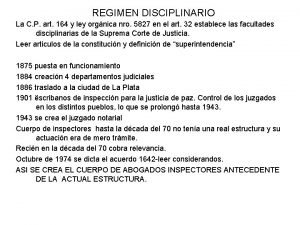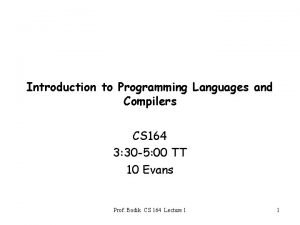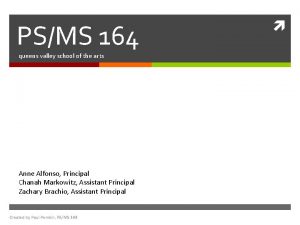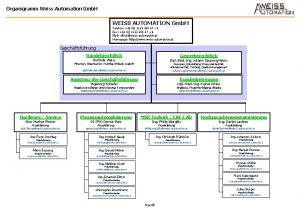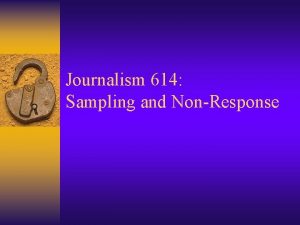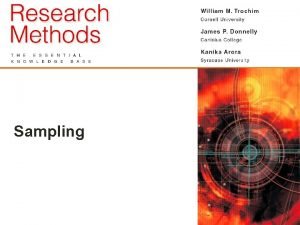Sampling Team 4 164 S 17120 Weiss 164













- Slides: 13

Sampling Team 4: 164 S 17120 侯希彤 Weiss 164 S 17117 杭琦 Vicky 164 S 17115 顾天玉 Doris 164 S 17132 陆于嘉 Yoga 16417107 陈悦蓉 Cas

Contents 01 Simple sampling 03 Systematic random sampling 02 Stratified random sampling 04 Cluster sampling

Simple Sampling Definition: Simple random sampling is to ensure that every possible sample of size n has the same probability of being sampled. For example, access objects are extracted according to the "lottery method" and "random table" method, and objects are extracted from the company's person name directory.

Advantage: Simple sampling has a high degree of randomness and a high degree of overall representation in a population with uniform characteristics; it is also the simplest sampling technique with standard and simple statistical formulas. Disadvantages: Simple sampling does not use the sampling frame which may be useful to assist in sampling, which may lead to low statistical efficiency; it is possible to take a "bad" sample, which makes the sample distribution bad and can not well represent the population.

Stratified random sampling It is to divide the survey population into homogeneous and non intersecting layers (or types), and then take samples independently from each layer (or type). For example: in the survey of retail stores, according to the size of their scale or inventory size, then in each layer, select a number of large-scale retail stores, medium-sized retail stores and small-sized retail stores by simple random method; in the survey of cities, according to the total urban population or industrial production, divide them into super large cities, medium-sized cities and small cities, and then select a number of specific types of cities.

Advantage: It is applicable to the population with large heterogeneity between layers, and the population with homogeneity within each layer can improve the accuracy of population estimation. Under the sample size, its accuracy is higher than that of simple sampling and systematic sampling; it can ensure the representativeness of "layers" and avoid "poor" samples; at the same time, different sampling frames and sampling methods can be adopted for different layers according to the situation.

Disadvantages: It requires high-quality auxiliary information that can be used for layering; because of the need for auxiliary information, the creation of sampling box needs more cost and complexity; sampling error estimation is more complex than simple sampling and systematic sampling.

Systematic random sampling Definition: The units in the population are first arranged in a certain order and numbered, and then sampled according to different rules. One of the most commonly used is equal distance sampling, which is to calculate the sampling distance (i. e. the same interval) according to the total number of units and sample units, and then select sample units according to the same distance or interval. For example: select 10 access numbers from 1000 phone numbers, with a spacing of 100. After determining the starting point (starting point < spacing), select one access number for every 100 numbers.

Advantage: It has the function of simple operation and statistical inference, and is the most widely used sampling method at present. If the starting point is determined randomly, the unit arrangement in the population is random, and the effect of isometric sampling is similar to simple sampling; compared with simple sampling, under certain conditions, the sample distribution is better. Disadvantages: The sampling interval may encounter some unknown periodicity in the population, resulting in "poor" samples; the sampling frame may not be used to assist in sampling, which may lead to low statistical efficiency.

Cluster sampling First divide the population into i groups, then randomly select several groups from the i groups, and investigate all individuals or units in these groups. The sampling process can be divided into the following steps: 1. Determine the label of the group 2. The whole (N) is divided into several non-overlapping parts, each part being a group. 3. According to the size of each sample, determine the number of groups that should be drawn. 4. Use simple random sampling or systematic sampling method to extract the determined number of groups from the i group. For example, to investigate the situation of middle school students suffering from myopia, select a class for statistics; conduct product inspection; select all products produced every 1 h every 8 h for inspection.

Advantage: The advantages of cluster sampling are easy implementation and cost savings. Disadvantages: The disadvantage is that due to the large difference between different groups, the sampling error caused by it is often greater than that of simple random sampling, and the sample is not widely distributed and the sample is relatively poorly representative of the population.

Summary The concept of sampling is to regard the set of all components of a certain numerical index of the object under investigation as a population. Each element constituting a population is regarded as an individual. The set composed of a part of individuals extracted from the population is called a sample, and the number of individuals in the sample is called the number of samples.

Thank you for watching
 Cluster sampling vs stratified sampling
Cluster sampling vs stratified sampling Systematic sampling disadvantages
Systematic sampling disadvantages Sampling frame in research example
Sampling frame in research example Clustered vs stratified sampling
Clustered vs stratified sampling Natural sampling vs flat top sampling
Natural sampling vs flat top sampling Contoh time sampling
Contoh time sampling Probability vs non probability sampling
Probability vs non probability sampling 158 164
158 164 Kj 164
Kj 164 Art 164
Art 164 Cs 164
Cs 164 Psms 164
Psms 164 E.164 format
E.164 format Yajurveda chapter 40 verse 9
Yajurveda chapter 40 verse 9









